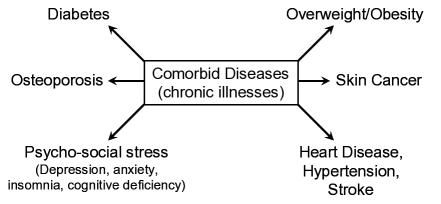|
Fifth Dimension Site Map Search Contact Us |
|

|
Comorbidities |
|
Comorbid Disease (Chronic Illnesses) Comorbid diseases are chronic illnesses existing simultaneously with and usually independent of another medical condition - in our case, cancer. Scientific studies1 have now shown that cancer will increase the severity and outcome of comorbid chronic illnesses, which are usually present 5-15 years before a cancer diagnosis. Comorbid diseases make the treatment of cancer more difficult.
Preventing cancer and successfully treating comorbidities are vital for survivors. Preventive medical care is important for preventing illness, but unfortunately, many Americans do not have the opportunity for preventive health care. Stopping smoking, weight control, exercise, diet, limited alcohol and psychological support programs are not always provided by physicians, sometimes due to the problem of cost or time necessary to have discussions for education. Obesity may increase risk of developing various cancers meriting control. Preventive programs and risk reduction are now accepted as beneficial preventive medicine. Therefore, getting a periodic checkup every one to two years is a good idea. A recent research study showed that 69% of cancer survivors had one chronic comorbid illness, 33% had two or more comorbid diseases, and that, of all cancer survivors, 76% were African Americans.2,3 In the study, the risks of seven comorbid diseases (esophagus, colon, rectum, endometrial, prostate, and kidney, as well as breast cancer in postmenopausal women) correlated with smoking, unhealthy diet, lack of physical exercise, and alcohol abuse. Smokers had an increased risk for all cancer sites, as well as the seven comorbid diseases.4 The number and severity of a survivor's comorbid conditions affect clinical care, treatment options, health service needs, and prognosis. A person's age, level of education, gender, smoking history, financial/economic security, and occupational exposures also affect the severity of comorbid diseases and survival. In the past, most chronic comorbid illnesses were caused by infections. As the life expectancy of our national population has increased over the past ten decades, age and unhealthy lifestyles have been seen to play a major role in the incidence of comorbid diseases. Cancer survivors often have multiple cancer-related risk factors, but if healthy preventive behaviors have been implemented early in life, the longevity of survivors can certainly be extended, as well as their quality of life to reduce the risks of comorbidities. Healthy lifestyle behaviors not only reduce cancer risk, toxic side effects of cancer treatment, second cancers and recurrences, they can also reduce the risk of comorbid diseases. Breast Cancer - deaths from non-breast-cancer-related comorbid diseases
References
|
|||
|
You are welcome to share this © article with friends, but do not forget to include the author name and web address. Permission needed to use articles on commercial and non commercial websites. Thank you. Index Cancer Supportive Care Survivorship | Card Catalog Site Map | Site Index | Search CancerSupportiveCare.com | Contact Us | Books | Top
First appeared August 30, 2009; updated September 1, 2009 |
||
